

Dear Members (a note from Deb Hickey):
A friend invited me on a “free cruise” last month. I’d never been on a cruise before—mainly because I’ve seen enough “I survived the norovirus” memes to know that floating in a metal tube with hundreds of strangers and their germs is not my idea of a vacation. But it’s free, right? Wrong. After I signed up to be my friend’s “plus one” and she “officially” submitted my name as her roommate, I discovered that staying alive and having any fun on a cruise ship requires purchasing about 10 “packages.” There’s the dinner package, the breakfast package, the beverage package, the Wi-Fi package, the excursion package… and don’t forget the port fees and mandatory gratuities.
My free cruise cost two grand.
To make things more interesting, our early morning flight to catch the ship in Miami, FL was canceled due to the one and only snowstorm the northeast coast got this year. No big deal—we rescheduled on the same airline for 10 a.m. That flight was also canceled. We were finally able to book a flight on another airline although we couldn’t get directly to Miami where the ship was docked; instead we could fly only to Ft. Lauderdale (by way of Baltimore, MD, because that’s part of the fun). As an added bonus, before the first plane left Boston, it had to be de-iced three times due to dropping temperatures and excessive waiting on the tarmac.
When we arrived in Baltimore, we’d already missed our flight to Ft. Lauderdale. We found another flight a couple hours later, although it had to stop in Chicago because it totally makes sense to stop in Chicago on the way to Florida from Baltimore.
We missed the ship.
By the time we made it to Ft. Lauderdale, it was 1a.m. We got an Air BnB somewhere near the airport. While there, my friend called the cruiseline to make sure we could meet the ship at the first port in Cozumel, Mexico. She found the 800 customer service number for Royal Caribbean on Google. We later found out she’d been scammed; the phone number went to a cybercriminal in Cambodia who charged $4,000 to her credit card.
Although the cruise itself was quite enjoyable, we both came down with the flu upon returning home, and I’ve decided I will never take another cruise. I’ve also learned that the expression, “nothing in life is free,” is 100% true.

But here’s some good news—remember Richard Humphreys and his incredible journey that captivated our readers back in 2022? Well, it’s three years later, and we have an astonishing update that will leave you speechless. This month, we’re bringing you the next chapter of Richard’s story—and trust us, it’s something you need to read to believe. Don’t miss out on this powerful and inspiring follow-up!
In this issue, we also share a remarkable discovery by scientists studying proton therapy —an unexpected breakthrough that could significantly improve its efficiency. We also introduce two promising new prostate cancer treatments in development, including one involving a targeted steam blast aimed at patients with intermediate-risk prostate cancer. Additionally, there’s new research suggesting that aspirin could play
a surprising role in preventing the spread of prostate cancer, along with other types of cancer. There’s also a cautionary warning about some at-home prostate cancer tests.
In our Health section, discover how something that enhances the look and taste of some foods could also harm your health. We bring you insights from a cancer dietitian on the three things you should never do. And we reveal the remarkable impact of exercise on brain cells.
As always, we welcome any suggestions you have on improving the value of the BOB Tales to our members. Please send your feedback to [email protected].
Deb Hickey

*Click here for the printable PDF version of this newsletter.

- Scientists Use Water to Improve Proton Beam Efficiency in Groundbreaking Discovery
- Two Promising Prostate Cancer Therapies Under Study
- Aspirin May Block Cancer Spread by Boosting Immune Response
- New Concerns About At-Home Prostate Cancer Blood Tests
- Special Segment: From Near-Death to New Life: The Incredible Journey of Richard Humphreys
- What Makes Food More Appealing May Also Make you Sick
- Cancer Dietitian’s Warning—3 Things You Should Never Do
- The Remarkable Impact of Exercise on Brain Cells
Scientists Use Water to Improve Proton Beam Efficiency in Groundbreaking Discovery
Scientists have made an exciting breakthrough in proton beam technology, which could lead to cheaper and more accessible treatments for cancer and advancements in industry. They discovered that using a simple stream of water, instead of traditional solid targets, could drastically improve proton
beam efficiency.
Explainer: When scientists use high-powered lasers to create proton beams, they need a material for the laser to hit, which is referred to as the “target.” Traditionally, solid materials like metal plates have been used as targets. But in this new experiment, researchers used a thin stream of water as the target instead of solid material. This water stream was chosen because it can quickly replenish itself after each laser pulse, which is something the solid targets couldn’t do.
When high-powered lasers hit the water, they created a proton beam as expected. But something unexpected happened—the water’s vapor cloud generated magnetic fields that focused the proton beam, making it more powerful and stable. This discovery boosted proton beam efficiency by 100 times and eliminated the need to replace targets after each laser pulse, a major issue in previous experiments.
“This work has shifted the whole paradigm,” said Siegfried Glenzer, professor of photon science and the director of the High Energy Density Science division at the Department of Energy’s SLAC National Accelerator Laboratory. “Finally, we are no longer totally reliant on simulations. We can now drive the physics from an experimental point of view, testing different laser intensities, target densities, and environmental pressures. The entire physics regime is in front of us.”
This breakthrough could lead to compact, cost-effective proton beam accelerators that can be used in medical treatments, like cancer therapy, and in other scientific applications. The team’s discovery is a major step toward making these proton beam systems more practical and scalable for real-world use.
Two Promising Prostate Cancer Therapies Under Study
Two innovative therapies for prostate cancer are being explored: a 10-second steam blast and an innovative drug targeting treatment-resistant tumors. While these therapies are still in the early stages of research and could take years to develop, they offer exciting potential for changing the future of prostate cancer care. Here’s a closer look at both.
A Targeted Steam Blast for Intermediate-Risk Prostate Cancer
As part of a nationwide, multi-center clinical trial, researchers are exploring the use of steam to treat prostate cancer. This pioneering method involves transurethral (through the urethra) water vapor to target and destroy cancer cells. These precise bursts of steam offer a promising alternative to traditional treatments like surgery and traditional radiation, which often come with significant side effects.
The steam procedure is designed to be less invasive and more precise, providing an option for patients with intermediate-risk prostate cancer. Additionally, the therapy can be performed in a single outpatient session, reducing the amount of time patients need to spend in the hospital.
However, it’s important to note that this is still an early-stage trial, and the results will need to be monitored over the next few years to determine its long-term effectiveness and safety.
An Experimental Drug for Hormone-Resistant Prostate Cancer
NXP800 is an experimental drug showing promise in treating prostate cancer and other cancers. The drug targets a key cellular pathway called HSF1, which helps cancer cells survive under stress. By blocking this pathway, NXP800 could slow tumor growth and make cancer cells more vulnerable to treatment.
In prostate cancer, NXP800 is especially promising for patients whose cancer has become resistant to traditional hormone therapies like enzalutamide. Early lab and animal studies have shown that NXP800 can shrink prostate tumors, even in those resistant to other treatments. This is a major breakthrough, as drug resistance is a common and difficult challenge in advanced prostate cancer.
Although NXP800 is still in the early stages of testing and more research is needed, the drug has the potential to offer new treatment options for patients with resistant prostate cancer and other cancers, providing hope for more effective therapies in the future.
Aspirin May Block Cancer Spread by Boosting Immune Response
New research suggests that aspirin could play a surprising role in preventing certain cancers, including breast, bowel, and prostate cancers, from spreading. In a study with mice, aspirin helped the immune system fight off cancer cells that had started to spread, reducing the growth of secondary tumors. It does this by lowering a clotting factor that suppresses immune cells, allowing them to destroy the spreading cancer.
Scientists are excited by the potential of aspirin, a cheap and common drug, to delay or prevent cancer recurrence, especially in the “window of vulnerability” when cancer cells are most susceptible to immune attack. While still in the early stages, this discovery could lead to new, easy-to-administer therapies that stop cancer from spreading after the initial tumor is removed. 
New Concerns About At-Home Prostate Cancer Blood Tests
New research has raised concerns about the potential inaccuracy of at-home prostate cancer blood tests. A recent analysis of five rapid tests revealed varying results, with some tests returning false positives, while others showed clear negative results despite a higher PSA reading from a laboratory test. This inconsistency can cause unnecessary anxiety or false reassurance for users. Experts caution that these home kits lack the reliability and nuance of clinical tests, which take into account other risk factors and offer more detailed readings.
► BOB Comment: It’s important to note that this research specifically
applies to at-home blood tests. There has been no new information regarding the accuracy of at-home urine or saliva tests, which we’ve covered in past newsletters. However, it’s important to note that none of these tests should be seen as a replacement for comprehensive screening conducted in a medical setting.

The rise in home test kits is filling the gap for those seeking earlier screening, offering convenience and accessibility. However, these tests may be marketed with misleading claims about their accuracy, leading to potential risks such as delayed diagnoses for those who receive false negative results, or unnecessary worry for those who receive false positives. Without proper guidance from a healthcare professional, users may misinterpret the results, which can ultimately delay critical medical intervention or lead to unnecessary anxiety and further unneeded testing.

From Near-Death to New Life: The Incredible Journey of Richard Humphreys
By Bob Marckini
More than three years ago, I had the privilege of meeting a remarkable man named Richard Humphreys through a mutual friend. At the time, Richard was a 71-year-old retired mechanical engineer living in Sequim, WA. His story, filled with adventure, resilience, and ultimately, a miraculous recovery, is nothing short of inspiring. We wrote about Richard in our Nov. 2022 BOB Tales. What’s happened since then is beyond remarkable.
A Life of Adventure
Richard spent much of his career traveling the world as a project manager, overseeing gold mine start-ups in some of the most remote and challenging places on Earth—South America, Siberia, South Africa, and even the North Pole. His work was grueling, often requiring him to go days with little sleep as he pushed himself to ensure the success of each project. Along the way, he battled and survived dengue fever, yellow fever, and twice fought off malaria. Despite these challenges, Richard enjoyed a relatively healthy life and rarely visited doctors. Unfortunately, this meant that he also never went in for routine physicals—a decision that would have significant consequences later.
A Devastating Diagnosis
About four years ago, Richard began experiencing urinary problems and finally went to see a doctor. The news was devastating—he was diagnosed with advanced, metastatic prostate cancer that had spread extensively throughout his body. The prognosis was grim. His doctors told him the cancer was inoperable and untreatable. The only option offered to him was androgen deprivation therapy (also called ADT or hormonal therapy), intended not to cure but merely to slow disease progression and extend his life for a few more weeks or months.
While some tolerate ADT quite well, others have reported nasty side effects. The side effects for Richard were brutal, robbing him of his quality of life. “I experienced every conceivable side effect,” he told me. The impact was so severe that he ultimately chose to stop treatment, knowing that doing so would certainly shorten his life. To complicate matters further, the pain from his spreading cancer was becoming unbearable. “I was taking six to eight Vicodin a day and even that wasn’t helping much,” he recalled.
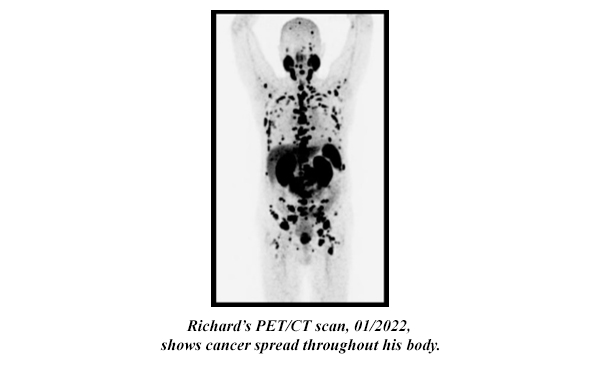
A Lifeline Emerges
It was during this difficult period that Richard and I were introduced by a mutual friend, asking me if I had any suggestions. Richard and I spoke at length, and we immediately connected. I felt compelled to do whatever I could to help him.
Around that time, I’d learned from Dr. Richard Hart, president and CEO of Loma Linda University Heath (LLUH) about a revolutionary new treatment being researched and developed at the Loma Linda University Cancer Center (LLUCC), called Theranostics. This is one of four new and revolutionary cancer fighting technologies, currently being researched at Loma Linda.
A Truly Revolutionary Treatment
Theranostics is a cutting-edge approach that combines diagnostics and targeted therapy to locate and destroy cancer cells. The process involves infusing the patient with a unique, short-lived isotope that seeks out and binds to cancer cells, many of which are microscopic and undetectable by conventional imaging. Once the cancer is located, a radioactive atom is attached to the same molecule and reintroduced into the body, where it targets and destroys the cancer cells while leaving healthy cells unharmed.
I reached out to Dr. Frankis Almaguel, a brilliant radiologist, researcher, and nuclear medicine specialist who was heading up the Theranostics program at LLUH. After reviewing Richard’s case, Dr. Almaguel felt that Richard was a good candidate for the clinical trial.
A Miracle in the Making
Just days after his first Theranostics treatment on Jan. 15, 2022, things started to happen. “Four days after the treatment, my pain was gone!” Richard told me with excitement. Within a few weeks, a Ga-68 PSMA PET/CT scan revealed that 80 percent of the cancerous lesions had disappeared. Richard underwent four more sessions of Theranostics, and the results were nothing short of miraculous.
In November 2022, a PET/CT scan, that once showed more than 130 lesions throughout his body, was almost completely clear. His PSA, which had been in the hundreds, had dropped to undetectable levels. Never expecting to see his 72nd birthday, Richard will be celebrating his 75th this September.
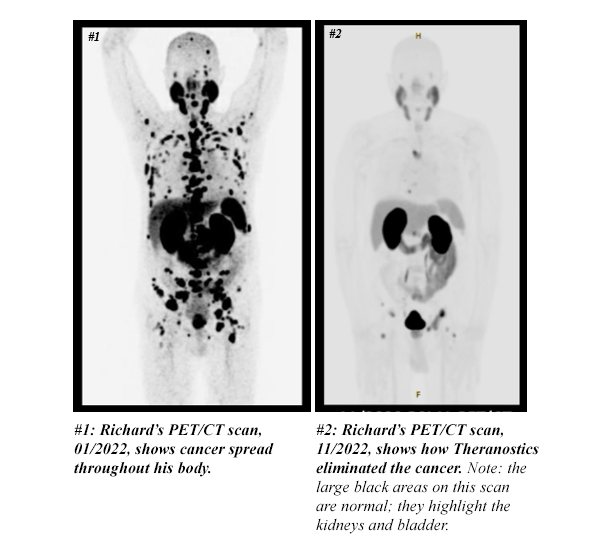
A New Lease on Life
Since his recovery, Richard’s life has transformed in remarkable ways. He recently completed a project installing a new engine in his prized 1929 Waco Taper Wing plane and is working on his 1952 Cessna 170. He’s also preparing his three-axle motor home for a trip across the Pacific Northwest with his wife, Margot, and their two dogs. “I’m one lucky guy,” Richard says. “Life is good—very good.”
Although he still experiences some minor side effects, including dry mouth and reduced taste and smell, Richard’s quality of life has improved dramatically. “I haven’t needed pain medication since my first treatment three years ago,” he proudly shared.
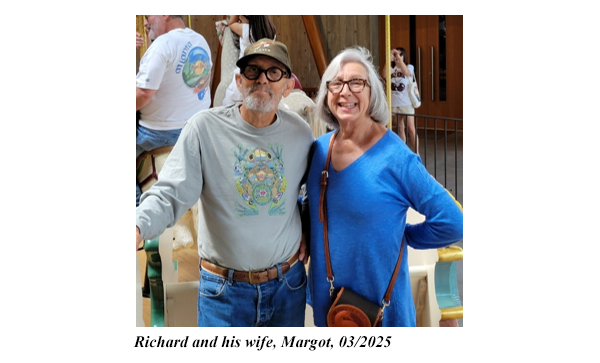
Giving Back and Spreading the Word
Richard’s gratitude has fueled a new mission—helping to spread the word about Theranostics and helping to raise awareness and funds for LLUH’s Stronger Together initiative, which supports cancer research and three other new treatment technologies. Richard often volunteers to speak about his experience and offer hope to other patients facing a similar diagnosis.
A Moment That Says It All
One of my favorite stories Richard shared with me highlights just how remarkable his journey has been. At Dr. Almaguel’s request, Richard attended a presentation in Florida, given to a group of 65 physicians, scientists, and researchers. During the talk, Dr. Almaguel displayed Richard’s initial PET/CT scan, which was riddled with cancer. One of the attendees at Richard’s table—not knowing Richard was the patient—not-so-quietly remarked, “That’s a dead man walking.” Moments later, Dr. Almaguel displayed a second scan taken after Richard’s treatment—showing a body almost entirely free of cancer. When Dr. Almaguel asked his patient to stand, jaws dropped around the room—especially at Richard’s table.
A Grateful Heart
Richard often tells me, “You saved my life!” But my response is always the same: “Dr. Almaguel and Loma Linda saved your life, Richard. I was just the middleman.”
Richard’s story is a testament to the power of innovative medical research, perseverance, and the unwavering will to fight. His journey from the brink of death to a vibrant, fulfilling life is nothing short of extraordinary—and it’s a story that continues to inspire all who hear it.
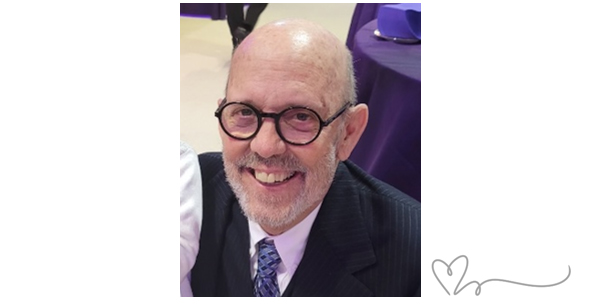


A Lesson Learned from Richard Humphreys' Story
JFK’s words resonate on many levels. Taken literally, it’s simple: don’t wait for a downpour to call the roofer. But beyond home maintenance, this wisdom applies to how we prepare for the unexpected in life. We save for retirement long before it arrives, ensuring financial security when we need it most. The same foresight applies to life-saving medical breakthroughs — investing in research and innovation today means hope and healing tomorrow.
A Life Saved by Innovation
Richard Humphreys’ story is a testament to this truth. When Richard was diagnosed with advanced cancer, a cutting-edge treatment called Theranostics gave him a fighting chance. But that technology didn’t appear overnight. It became available because LLUH had the vision and commitment to invest in research long before it was widely known. Just as they pioneered proton therapy decades ago—a treatment we have all benefited from—LLUH is now leading the charge in developing groundbreaking technologies that could save countless lives.
Four New Frontiers in Cancer Treatment
Today, LLUH is working on four revolutionary cancer treatments:
- CAR-T Cell Therapy – A personalized immune system approach to target and destroy cancer cells.
- Boron Neutron Capture Therapy (BNCT) – A precise radiation therapy designed to kill cancer cells while sparing healthy tissue.
- Flash Proton Therapy – A powerful new form of targeted radiation that delivers treatment in milliseconds, minimizing side effects.
- Theranostics – A personalized treatment that combines diagnostics and therapy to target cancer at its source.
Each of these life-saving technologies holds incredible promise. But to bring them to the masses—to people like Richard, and perhaps to our own loved ones—it takes more than scientific brilliance. It takes resources: funding for research, facilities, equipment, and expert staff.
Where We Come In
LLUH’s Stronger Together campaign aims to raise $100 million in philanthropy to accelerate these efforts. The faster we help fund these projects, the sooner these technologies will be available to those who need them most. Some of our members have already stepped up — one even made a $1 million gift. But every contribution, no matter the size, brings us closer to a future where cancer can be fought with the most advanced tools available.
Make a Difference Today
We have the power to help shape that future. Every dollar we give moves these technologies closer to reality. Whether it’s a small monthly donation or a larger contribution, our collective support will make an impact—and possibly save the lives of people we know and love.
Ways to Contribute to LLUH’s Stronger Together Campaign
Click here to see how you can make a gift to the Stronger Together campaign. Using the Gift Designation dropdown menu, you can choose to direct your gift to:
- Pediatric Cancer Research
- The Research and Treatment Building
- Make an Unrestricted Gift
We recommend making an “unrestricted” gift so it can be used where it’s needed
most.
Let’s not wait for the rain. Let’s strengthen the roof now, while the sun is shining, and give hope to those who will need it most in the future.

What Makes Food More Appealing May Also Make You Sick
Emulsifiers, widely used to improve food texture and shelf-life, are under increasing scrutiny due to potential health risks. These additives help prevent separation in salad dressings, maintain consistency in ice cream, and keep baked goods soft. However, emerging research suggests they may contribute to serious health conditions, including heart disease, Type 2 diabetes, and certain cancers, by altering the gut microbiome and triggering inflammation.

Studies indicate that emulsifiers may partly explain the link between ultra-processed foods and chronic diseases. The Trump administration, particularly under Robert F. Kennedy Jr., has prioritized investigating food additives, including emulsifiers, due to their suspected role in widespread health issues.
Historically considered safe due to their poor absorption by the body, emulsifiers are now understood to disrupt gut bacteria, leading to inflammation. These additives are challenging to avoid since they are tasteless, invisible, and commonly found in both junk food and seemingly healthful items like yogurts and whole-grain products. A study of 126,000 packaged food products in France found emulsifiers in 54% of them.
The food industry defends emulsifiers, emphasizing their role in food consistency and their approval by the FDA following rigorous safety evaluations. Emulsifiers come in various forms: synthetic ones like carboxymethylcellulose and polysorbate 80, and natural ones like soy lecithin and guar gum.
Observational studies tracking around 92,000 to 104,000 individuals over seven years suggest a correlation between emulsifier intake and increased risks of Type 2 diabetes, cardiovascular disease, and cancer. While these studies do not establish causation, they highlight concerning patterns. Research also suggests emulsifiers can reduce microbial diversity, increase harmful bacteria, and decrease beneficial bacteria in the gut, potentially leading to inflammation throughout the body. A 2022 study found that consuming carboxymethylcellulose for 11 days resulted in significant microbiome changes, including bacteria invading the gut’s inner mucus layer, a condition linked to systemic inflammation.
Animal studies reinforce these findings, and researchers in the U.K. and France are exploring whether a low-emulsifier diet could help manage Crohn’s disease.
While avoiding emulsifiers entirely may be unrealistic, experts recommend minimizing consumption of synthetic emulsifiers like carboxymethylcellulose and polysorbate 80, as well as gums such as guar and xanthan gum, which disrupt gut bacteria. Carrageenan, commonly found in low-fat dairy products, is also flagged as problematic. Soy lecithin, a more natural emulsifier, is considered less harmful.
Consumers can use resources like Open Food Facts, a crowdsourced database, to identify emulsifiers in foods. However, experts stress that overall diet quality remains the primary determinant of health. A yogurt or bean dish containing stabilizers is still nutritionally superior to highly processed foods like bacon or candy. While emulsifiers may pose risks, prioritizing whole foods and minimally processed options remains the best approach to a healthful diet.

Cancer Dietitian's Warning─3 Things You Should Never Do
Oncology dietitian Nichole Andrews is all about making informed choices when it comes to cancer prevention. In a recent Instagram post, she shared three key things she avoids to reduce her risk of colon and other cancers.
“Knowledge is power,” says Andrews, “and I’m here to drop some truth bombs on how to lower cancer risk.”
Her insights come at a time when cancer diagnoses, including those for breast, prostate, and pancreatic cancers, are on the rise in the US. Colorectal cancer, in particular, is seeing a concerning uptick among younger adults.
“Small daily changes can have a huge impact on your overall health, both mentally and physically,” Andrews explains. She then reveals three things that don’t make it onto her to-do list.
- Processed meats: These foods, such as deli meats, sausages, and bacon, are loaded with preservatives like nitrates and nitrites. The World Health Organization has classified them as carcinogenic, linking them directly to an increased risk of colorectal cancer. High-temperature cooking methods, like grilling or frying, can also produce harmful chemicals, making processed meats a no-go for Andrews.
- Alcohol: “I completely cut it out,” she says. “There’s a lot of hype around alcohol as a stress-reliever, but the truth is, it increases the risk of at least seven cancers, including breast, liver, and throat cancer. It also raises hormone levels that are linked to cancer, especially breast cancer.”
- Supplements: Andrews advises against using supplements to lower cancer risk, pointing out that high doses can actually increase the risk. For instance, large doses of beta-carotene supplements have been linked to higher rates of lung cancer in smokers. “I don’t take any supplements unless my doctor specifically recommends them,” she says. “I get all my nutrients from food.”

By avoiding these three common pitfalls, Andrews is actively lowering her cancer risk, and she’s encouraging others to do the same.

The Remarkable Impact of Exercise on Brain Cells
A recent study published in Aging Cell reveals that exercise can reverse age-related changes in brain cells, offering promising insights for combating cognitive decline. Researchers found that regular exercise restored the gene expression of microglia, a type of brain cell involved in immune response, to a more youthful, anti-inflammatory state. This was particularly evident in aged mice, who showed improved brain health and cognitive performance after engaging in regular exercise. The study also highlighted that exercise reduced harmful T cell accumulation in the brain, which is associated with inflammation and cognitive decline.
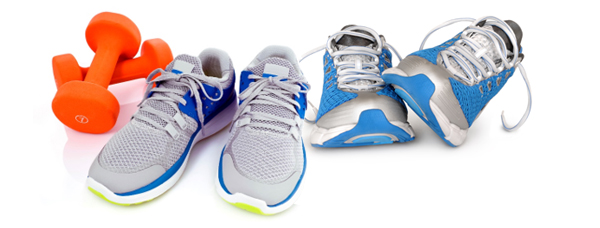
The findings suggest that exercise not only rejuvenates microglia but also has a broad impact on various brain cells, improving overall brain function. Additionally, the study demonstrated that exercise led to better performance in memory tests, providing further evidence that physical activity can enhance cognitive function, even in older individuals. These results may lead to new strategies for preventing or slowing age-related cognitive decline.
Researchers hope that these insights will encourage more elderly individuals to engage in physical activity and offer therapeutic approaches to those who are unable to exercise.

You Can Beat Prostate Cancer: And You Don't Need Surgery to Do It - Second Edition
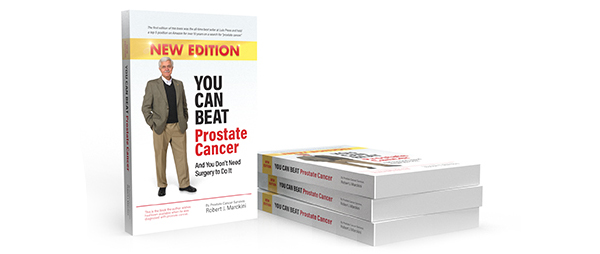
Still an Amazon Top Seller!
Bob’s second edition book continues to make a meaningful impact, as seen in the positive feedback on Amazon and the numerous messages we receive daily from readers.
On Amazon, the book is still holding steady in the No. 2 position on a list of more than 6,000 books on prostate cancer. And, the first and second editions have a combined 803 reader reviews, averaging an impressive five-star rating.
Help Others by Sharing Your Story
If Bob’s book played a helpful role in your treatment journey, we encourage you to share your experience with others. Many search the internet for guidance, and Amazon listings frequently appear in their search results. With over 2 billion visitors each month, over 90% of shoppers trust reviews to shape their purchasing decisions—particularly when seeking essential resources during life-changing moments. Taking just a few moments to write a review could make a profound impact on someone else’s path. Your feedback is invaluable, and we truly appreciate your support. Thank you!

Last Month's Brain Teaser
I can’t be bought but I can be stolen with a glance. I’m worthless to one but priceless to two. What am I?
Answer: Love
Winner: Alfred Compton of Gardendale, AL, is the winner of the March 2025 brain teaser! Alfred received treatment at MD Anderson in 2018.
“At 65, my PSA levels shot up significantly,” Alfred recalled. “Although my primary care physician referred me to a urologist, he also suggested I consider proton therapy because one of his patients had a positive experience.” After speaking with that patient, researching online, and “most important, reading Bob Marckini’s book,” Alfred was confident that proton therapy was the right path for him.
Alfred then saw the urologist recommended by his primary care doctor, where he underwent a biopsy and learned he had a Gleason 9 score. “The urologist never mentioned proton therapy, and when I brought it up, he told me my insurance wouldn’t cover it and that it would be too expensive,” Alfred said. “I no longer see him.”
Alfred sought further testing at MD Anderson in Houston, where the aggressive nature of his cancer was confirmed. He began a three-month regimen of Lupron and Casodex at home before relocating to Houston for two months to undergo 39 proton treatments.
Now 72 and cancer-free, Alfred enjoys traveling across the country in his RV, biking, hiking, and occasionally taking cruises (Oh no!). Most importantly, he cherishes time with family and friends.
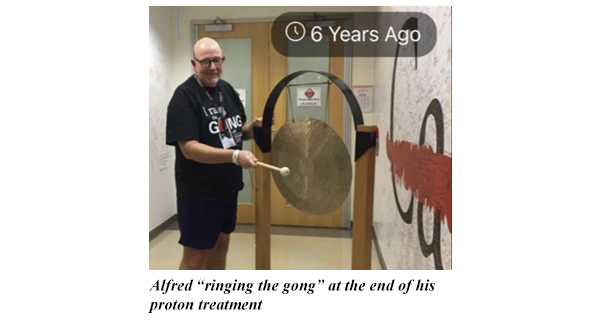
“I can’t say enough good things about the amazing people at MD Anderson,” Alfred said. “I’ve referred others there, and they’ve all expressed their gratitude for the recommendation.” Alfred has also loaned Bob’s book to many in his community, helping to spread the word about proton therapy.

New Brain Teaser
What is seen in the middle of March and April that can’t be seen at the beginning or end of either month?
Send your brain teaser answer to [email protected] for a chance to win a signed copy of Bob Marckini’s second edition book, You Can Beat Prostate Cancer.

Three Elderly Friends
Three old men are sitting on a park bench discussing aging.
The first one says, “I have trouble with my memory. Sometimes I walk into a room and forget why I went in.”
The second one says, “My arthritis is so bad, I can barely tie my shoes.”
The third one laughs and says, “Well, I don’t have any of those problems… Knock on wood.” He knocks on the bench, then suddenly looks confused. “Wait—is someone at the door?”
The Hearing Test
An elderly man thinks his wife is losing her hearing, so he decides to test it.
He stands behind her and says, “Can you hear me, honey?”
No response.
He steps a little closer and repeats, “Can you hear me now?”
Still nothing.
Finally, he stands right behind her and says loudly, “Can you hear me now?”
She turns around and says, “For the third time—yes!”

You Can’t Outsmart God
George climbs to the top of Mt. Sinai to get close enough to talk to God. Looking up, he asks the Lord, “God, what does a million years mean to you?”
The Lord replies, “A minute.”
Then George asks, “And what does a million dollars mean to you?”
The Lord replies, “A penny.”
George asks, “Can I have a penny?”
The Lord replies, “In a minute.”

Always Look on the Bright Side
On my way home the other day, I stopped to watch a Little League baseball game that was being played in a park near my home. As I sat down behind the bench on the first base line, I asked one of the boys what the score was.
“We’re behind 14 to nothing,” he answered with a smile.
“Really,” I said. “I must say—you don’t look very discouraged.”
“Discouraged?” the boy asked with a puzzled look on his face. “Why should we be discouraged? We haven’t been up to bat yet.”
Did You Know...
- Human teeth are the only part of the body that cannot heal themselves.
- Competitive art used to be an Olympic sport.
- People once ate arsenic to improve their skin.
- A fear of long words is called hippopotomonstrosesquippedaliophobia.
- No number before 1,000 contains the letter A.
- Penicillin was first called “mold juice.”
- The human circulatory system is more than 60,000 miles long.
- Walt Disney was afraid of mice.
- The first-ever product scanned with a barcode was a 10-pack of Wrigley’s gum in 1974.
- The dot over the letter “I” is called a tittle.
- Your stomach gets a new lining every few days. Otherwise, it would digest itself!


Revenge or Forgiveness?
“After I became president, I asked my escort to accompany me to a restaurant for lunch. We sat down, and each of us ordered what we wanted.
On a nearby table, there was a man waiting to be served. When he received his meal, I said to one of my soldiers, ‘Go and ask that gentleman to join us.’ The soldier went over and conveyed my invitation. The man got up, took his plate, and sat down right next to me.
As he ate, his hands trembled constantly, and he never lifted his head from his food. When we finished, he said goodbye without looking at me. I shook his hand, and he left.
The soldier then turned to me and said, ‘Madiba, that man must be very ill. His hands didn’t stop shaking the entire time he ate.’
‘Absolutely not,’ I replied. ‘The reason for his trembling is something else.’ Then, I told him, ‘That man was the warden of the prison where I was held. After he tortured me, I screamed and cried for water, but instead of helping me, he humiliated me, laughed at me, and urinated on my head.’
‘He is not sick—he was afraid. He feared that now, as president of South Africa, I would seek revenge and do to him what he once did to me. But I am not like that. Such actions are not part of my character or my ethics. Minds that seek revenge destroy states, while those that seek reconciliation build nations.’
As I stepped out the door to begin a new chapter in my life, I realized that in order to truly embrace my freedom, I needed to let go of all the anger, hatred, and resentment that had weighed me down. Holding onto those negative emotions would only keep me imprisoned.”
─Nelson Mandela (Source)

Low PSAs to all,
Bob Marckini and Deb Hickey
*Click here for the printable PDF version of this newsletter.
NO MEDICAL ADVICE: Material appearing here represents opinions offered by non-medically trained laypersons. Comments shown here should NEVER be interpreted as specific medical advice and must be used only as background information when consulting with a qualified medical professional.


